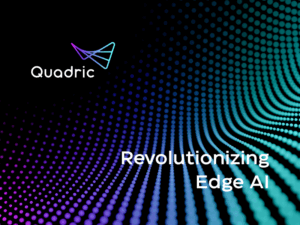Key Takeaways
- Quadric, Inc. is a pioneering company in edge computing, developing high-performance, energy-efficient processors for AI workloads in devices such as smartphones, IoT sensors, and autonomous vehicles.
- The Chimera General-Purpose Neural Processor (GPNPU) integrates general-purpose computing flexibility with specialized AI hardware efficiency, allowing it to handle diverse workloads including machine learning inference and signal processing.
- Quadric's hybrid processor architecture delivers up to 10x better performance-per-watt compared to traditional solutions, optimizing latency and throughput by allowing execution in both linear code flow and dataflow-driven modes.

In the rapidly evolving landscape of AI, Quadric stands out as a pioneering force in edge computing. Founded in 2018 and headquartered in Burlingame, California, Quadric is a technology company focused on developing high-performance, energy-efficient processors for AI workloads at the edge devices like smartphones, IoT sensors, autonomous vehicles, and industrial robots. Its flagship product, the Chimera processor, integrates the flexibility of general-purpose computing with the efficiency of specialized AI hardware, addressing the growing demand for on-device AI processing. This blog explores Quadric’s mission, technology, and impact on the edge AI ecosystem, highlighting its role in shaping the future of intelligent devices.
Quadric’s core innovation lies in its Chimera GPNPU, a hybrid processor that bridges the gap between traditional CPUs/GPUs and dedicated AI accelerators like TPUs. Unlike conventional neural processing units optimized solely for deep learning inference, the Chimera GPNPU combines a programmable architecture with specialized AI capabilities. This allows it to handle diverse workloads, including machine learning inference, signal processing, and classical computing tasks, all within a single licensable processor IP core. By unifying these functions, Quadric eliminates the need for multiple specialized processors, reducing complexity, power consumption, and cost—critical factors for edge devices where space and energy are constrained. For example, in autonomous vehicles, the Chimera can process real-time sensor data (e.g., LiDAR, radar) while running control algorithms, enabling faster and more efficient decision-making.
The Chimera’s architecture is a hybrid between a conventional C++ programmed DSP (the world’s largest and most capable, with up to 32,768 bits of parallelism) and hardware accelerator for convolutions and matrix math. It features a single instruction dispatch feeding into a massively matrix-parallel execution pipeline with up to 1024 of processing elements, optimized for matrix and vector operations common in neural networks. Unlike traditional GPUs that rely solely on sequential instruction pipelines, Quadric’s processor can switch into and out of two modes of execution, traditional linear code flow, or a dedicated matrix/convolution that executes operations in a dataflow-driven manner, minimizing latency and maximizing throughput. This hybrid of DSP behavior plus Accelerator behavior is what earned the architecture the Chimera brand name – a processor with the DNA of two very different architectures merged into one processor pipeline. This approach delivers up to 10x better performance-per-watt compared to competing solutions, according to Quadric’s benchmarks. Additionally, its software stack, including the Quadric SDK and Chimera graph compiler, allows developers to program in familiar frameworks like TensorFlow or PyTorch, ensuring compatibility with existing ML models while optimizing them for the Chimera’s unique architecture. Critically, the processor runs both C++ user code as well as user python code making the Chimera core far more flexible that competing hardwired accelerators.
Quadric’s impact extends across industries. In healthcare, its processors enable wearable devices to perform real-time diagnostics, such as detecting irregular heart rhythms, without relying on cloud connectivity, thus enhancing privacy and responsiveness. In industrial IoT, Quadric-powered sensors can analyze vibration or temperature data on-site, reducing latency and bandwidth costs. The automotive sector benefits from its ability to handle complex perception tasks in self-driving cars, where low power and high reliability are paramount. By processing AI workloads locally, Quadric’s technology also addresses privacy concerns, as sensitive data no longer needs to be transmitted to centralized servers—a growing priority in a data-conscious world.
Bottom line: Quadric is poised to shape the future of edge AI as devices become smarter and more autonomous. Its emphasis on general-purpose AI processing aligns with the trend toward heterogeneous computing, where no single processor type dominates. By enabling efficient, on-device intelligence, Quadric not only enhances performance but also democratizes AI deployment across resource-constrained environments. As edge AI demand grows to an estimated $70 billion market by 2030, Quadric’s innovative approach positions it as a key player in making intelligent systems ubiquitous, from smart homes to autonomous factories.
Visit Quadric Inc. for more information.
Ready to bring intelligence to the edge? Connect with a Quadric SME to explore your project.
Also Read:
Legacy IP Providers Struggle to Solve the NPU Dilemna
Recent AI Advances Underline Need to Futureproof Automotive AI
2025 Outlook with Veerbhan Kheterpal of Quadric
Share this post via:






Comments
There are no comments yet.
You must register or log in to view/post comments.